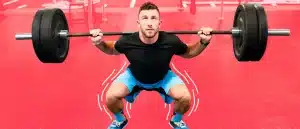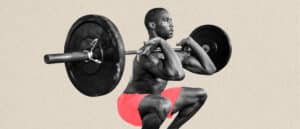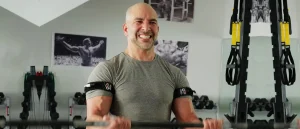Wait, Thinking Harder Can Grow More Muscle?
We get it. Your workout is your one chance of the day to let your mind go totally blank or at least daydream about dinner without distraction. The discomfort of lifting heavy can lead your mind to travel to all kinds of places to, for lack of a better term, get er’ done. But if your mind is somewhere on a beach mid-bicep curl there’s a good chance you’re leaving gains on the table.
According to bodybuilders and mic’d-up trainers everywhere, building your mind-muscle connection can help you shift from passively to actively moving the weight—a distinction they claim is key to better gains over the long run.
But is the mind-muscle connection legit? And more importantly, is it worth giving your attention to (literally)? Here’s everything you need to know, and how to link your mind and muscles to maximize every rep.
The Mind-Muscle Connection, Explained
Mind-muscle connection is focusing your mind to consciously and deliberately contract a specific muscle or muscle group that should be working during an exercise. For example, to harness the mind-muscle connection during a dumbbell bent over row, you’d pay attention to feeling your lats contract and lengthen with each rep, rather than zoning out and hoping for the best.
According to exercise science researcher, Brad Schoenfeld, Ph.D., CSCS, CSPS, FNSCA, mind-muscle connection (also known as “internal attentional focus”) can enhance muscle fiber recruitment and activation of a specific muscle group (1). And the more effectively you engage your muscles, the more hypertrophy (or muscle growth) you can expect.
Benefits of Developing the Mind-Muscle Connection
Honing in on a specific muscle group while lifting is worth the mental energy, here’s why:
Helps you target the correct muscles
When you focus on the specific muscles you’re using to execute an exercise, you’re better able to target primary movers—aka the muscles that should be doing most of the work to power a movement.
Take, Romanian deadlifts (RDL), for example. Raise your hand if you’ve ever done an RDL and had no clue which muscles you actually activated and which muscles should be activated. Exactly. The glutes and hamstrings are your primary movers, but if you don’t focus on using them your lower back may step up to take on more of the load (ouch).
This can all be fixed by building your mind-muscle connection. During a Romanian deadlift, focus on shifting your glutes back until you feel a stretch in your hamstrings. That biofeedback is a clue that you’re working the right muscles. Then turn your attention to activating the hamstrings and glutes to stand back up.
Promotes muscle growth
Channeling your mind-muscle connection can also help you build muscle. A study published in the European Journal of Sports Science found that individuals who focused on contracting a target muscle while lifting had greater improvements in muscle thickness after eight weeks of resistance training than people who simply focused on the movement outcome (2).
In fact, using mind-muscle connection may result in the ideal conditions for muscle growth to occur. “It is likely that the molecular signaling for all three primary mechanisms of muscular hypertrophy—namely mechanical tension, metabolic stress, and muscle damage—are increased when the exerciser focuses their attention internally, which could ultimately result in greater muscular development for a given exercise and load,” Schoenfeld and fellow researcher Bret Contreras, Ph.D., CSCS note in their review which was published in the National Strength and Conditioning Journal (1).
Improves movement quality
Lifting heavy isn’t everything (check your ego lifting at the door). To build muscle, moving through a full range of motion in a slow and controlled manner—maximizing mechanical tension and time under tension—can help boost gains (3). But when your brain is on auto-pilot it’s easier to let the details slip (think: squatting to 60 degrees rather than to or below parallel).
The act of thinking about how you want to move also naturally slows down a movement. This gives you time to focus on moving with precision and make form adjustments mid-rep or between reps.
Who Should (and Shouldn’t) Focus on Mind-Muscle Connection
If you’re focused on hypertrophy, make mind-muscle connection your bread and butter. Whether you’re a bodybuilder struggling to grow your lats, an average Joe who can’t feel your glutes during a hip thrust, or just looking to move better, mind-muscle connection can help.
That said, the mind-muscle connection has its limits. One study found that participants who intentionally focused on activating their chest muscles while performing bench press increased pec activation by 22 percent at a load of 50 percent of their one rep max (1RM). But the activation decreased to 13 percent when lifting at 80 percent 1RM (4).
Why? Schoenfeld suspects the need to exert greater levels of force at heavier loads takes your attention away from one specific muscle group. As it should. At heavy loads (loads 80 percent and above), all of your focus should go to executing your lift safely and effectively. One review found that performance-oriented tasks are optimized by using an external focus of attention, for example, focusing on lifting the weight versus what your glutes are doing (5).
This means mind-muscle connection isn’t super useful when you’re working with max and near-max loads. It also shouldn’t be the priority with explosive exercises like a barbell snatch. During complex, movements that require a lot of power, it can be dangerous to slow down and think about only one muscle group when so many muscle groups need to coordinate together to complete each rep. Don’t worry about how the movement feels, just focus on the movement outcome.
You can also hold off on worrying about the mind-muscle connection if you’re a beginner. When you’re new to strength training, just aim to learn how to complete basic exercises with good form. If you can move well, you’ll have the foundation you need to start connecting and controlling specific muscle groups. But worrying about the mind-muscle connection from the jump might just confuse you more and lead to wonky movement patterns.
How to Improve Your Mind-Muscle Connection
Ready to rip? Here’s how to start building mind-muscle connection to boost your gains.
Start with a single-joint exercise
Mind-muscle connection is ideal for single-joint, isolation exercises—like biceps curls—because you’re able to narrow your focus to one muscle group, without taking your attention away from any other important muscle groups that may be involved in a more complex move—like squats. That isn’t to say that the mind-muscle connection isn’t useful during compound exercises. You could focus on squeezing your glutes as you stand up from a squat, for example. To get a feel for mind-muscle-connection, however, give an isolation exercise like biceps curls, triceps extensions, or leg extensions a try first.
Use a light to moderate load
Going too heavy shifts your focus from internal (mindfully flexing your biceps) to external (using any means to complete the lift), negating any potential benefits of mind-muscle connection. Choose a weight below 80 percent, but ideally even lower—somewhere around 60 to 75 percent to start. Starting light will help take the pressure off of completing the lift, and help you focus on connecting with your muscles.
Perfect your form
Bad form can call on additional muscles in order to perform an exercise, which isn’t great whether you’re focused on mind-muscle connection or not. First, it can distract you from paying attention to the target muscle. More importantly, movement faults can lead to injuries. Who cares if you target one specific muscle if the rest of the movement is potentially detrimental to your other muscles and joints? If you don’t have good form, focus on improving it before you even think about mind-muscle connection.
Slow down
By slowing down your pace (lifting, holding, and lowering the weight) you increase muscle time under tension, which can help build muscle. Slowing down will also give you time to connect with a muscle. If you’re struggling to link your mind to a particular muscle group, think about the action it’s doing; for example, pushing the weight away from your body during a triceps extension.
Flex or touch a muscle to increase connection
Before beginning an exercise, flex or tap the specific muscle group your want to target. This can be helpful for activating particularly elusive muscle groups, like your lats during a bent-over row. Simply flexing your muscles can help remind you how and what it feels like to activate them. While tapping them brings your attention to the area you want to work on, helping you to connect to the muscle group.
Practice
Improving your mind-muscle connection is all about repetition. With mind-muscle connection, you’re actively helping your mind and body to connect. Just like riding a bike, it takes time for your brain to build muscle memory. Be patient, put in the work, and you’ll be rewarded with the ability to call on specific muscle groups when you need to move better, lift heavier, or pack on more mass.
The Bottom Line
Increasing mind-muscle connection can help you build muscle, increase body awareness, and make your workouts more effective. While mind-muscle connection can add an edge to your gym sessions, it isn’t the most important thing for building muscle. To maximize muscle, make sure you’re hitting enough volume, following a solid training plan, eating enough protein, and prioritizing recovery first. Once you have the basics covered, harnessing the mind-muscle connection can be the cherry on top.















